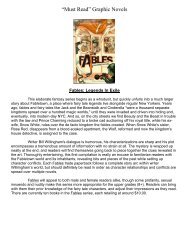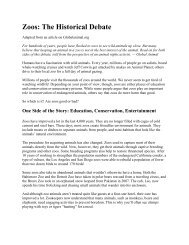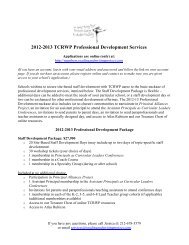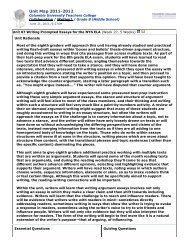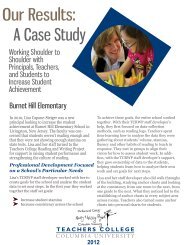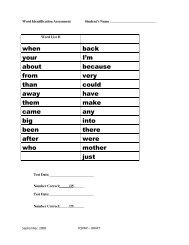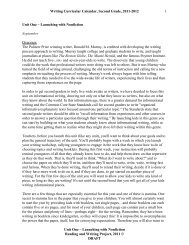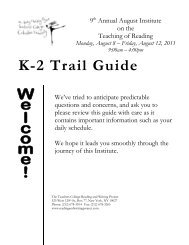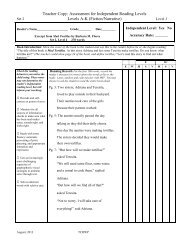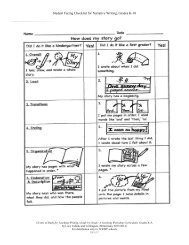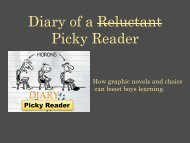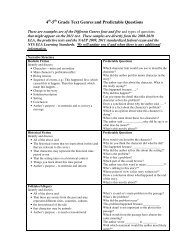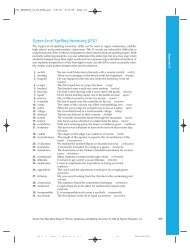K-8 Continuum for Assessing Narrative Writing - The Reading ...
K-8 Continuum for Assessing Narrative Writing - The Reading ...
K-8 Continuum for Assessing Narrative Writing - The Reading ...
- No tags were found...
You also want an ePaper? Increase the reach of your titles
YUMPU automatically turns print PDFs into web optimized ePapers that Google loves.
K-8 <strong>Continuum</strong> <strong>for</strong> <strong>Assessing</strong> <strong>Narrative</strong> <strong>Writing</strong>Note: When assessing levels 1, 2 and 3 texts, the child needs to be present.Level 1Several pictures may be representational, with oral commentary and perhapsapproximated lettersI Was HomeDad, Joe and Me/Structure • Treatment of subject/focuso When given a small booklet and asked to write a story, the writer makes acollection of pictures that may be nonrepresentational on many of thepages and, when asked to read his or her story, provides accompanyingoral comments that are not yet organized into a chronological account.o <strong>The</strong> pictures do not appear to be connected to each other, and it may beElaboration/Show Don’t Tellthat none of them depict an event.• Written in scenes produced through envisionmento <strong>The</strong> writer probably does not yet depict scenes in the drawing, andcertainly does not in the text.• Amount and organization of detailo If encouraged to do so, the writer may return to his or her initial drawingand revise it by adding more to the drawing.• Characters’ traits/ words/thoughts/feelingso Especially because the writer may make non representational marks, theremay be no sense of characters, let alone of characters doing events.• Settingo<strong>The</strong> writer’s illustration often includes marks which seem to float in theair, each separate from the next. At this stage, the child is not yet apt toground his or her marks onto a specific setting.Concept of<strong>Writing</strong>Meaning/Significance• <strong>The</strong> child seems to believe that pictures carry meaning because when asked to do so,the child ‘reads’ the text, telling about the items in the pictures.• Even when asked to ‘write the words,’ the child may not yet produce approximatedletter strings or different attempts at written words.• <strong>The</strong> child may not yet write to communicate a meaning, a specific content. That is,instead of deciding upon a meaning and then working to capture that on the page, thechild may make marks on the page <strong>for</strong> the sheer pleasure of making marks or toproduce a drawing that he or she knows how to make (e.g. of a flower) deciding on ameaning <strong>for</strong> the text only when asked to ‘read’ the text. <strong>The</strong> meaning may, in fact,change every time the child ‘reads’ the text.K-8 <strong>Continuum</strong> <strong>for</strong> <strong>Assessing</strong> <strong>Narrative</strong> <strong>Writing</strong> - TCRWP 2007-08Working Document - Do Not Duplicate1
Level 1 <strong>Writing</strong> Sample:K-8 <strong>Continuum</strong> <strong>for</strong> <strong>Assessing</strong> <strong>Narrative</strong> <strong>Writing</strong> - TCRWP 2007-08Working Document - Do Not Duplicate3
Level 2 A collection of representational pictures related to a single topic or event withaccompanying gestures toward writing.Zoo/ SabrinaStructure • Treatment of subject/focuso When given a small booklet and asked to write a story, the writer makesrepresentational pictures accompanied by attempts at writing.o When asked to read his or her story, the child produces an oralcommentary that encompasses the collection of pictures and pages oftext.o <strong>The</strong> pictures and pages are all related to a single topic or event. That is,the pictures and writing attempts are centered on a topic of choice,though probably not yet conveyed as a sequential narrative.o <strong>The</strong> text is more apt to tell all-about a topic or an event rather than toconvey a step-by-step progression through an event.Elaboration/Show Don’tTell• Written in scenes produced through envisionmento <strong>The</strong> writer often represents a character or two in his or her drawings.<strong>The</strong>se people (or animals) tend to be standing motionless, depictedthrough frontal views.o<strong>The</strong> writer may be gesturing towards visually recreating events. His orher drawings may, <strong>for</strong> example, show two characters and an object or twoaround which they relate – a TV, a car, a house, etc.• Amount and organization of detailo Often the child ‘reads’ the first page as if it contains one sentence, then‘reads’ the next page as if it contains the next sentence, etc.oIf the writer elaborates by including details, he or she is apt to do this byadding to the pictures or the oral text (and less apt to involve morewriting). This process of adding detail often continues as a child ‘reads’the text—each new time the child reads the text, he or she may add moredetails.• Characters’ traits/words/ thoughts/feelingso <strong>The</strong> drawing generally involves a character or two (a person or ananimal). Sometimes there is also an object (a car, a house, a tree).ooOften the pictures of characters’ faces show emotions.<strong>The</strong> oral ‘story’ that accompanies the pictures is probably a summary.<strong>The</strong>re<strong>for</strong>e, the writer probably does not yet convey dialogue or tell what acharacter is thinking.K-8 <strong>Continuum</strong> <strong>for</strong> <strong>Assessing</strong> <strong>Narrative</strong> <strong>Writing</strong> - TCRWP 2007-08Working Document - Do Not Duplicate4
Elaboration/Show Don’tTell Cont’d• Settingoo<strong>The</strong> writer’s drawings may situate items and people in a specific setting,with a line of grass or ground providing a unifying sense of place to whatmight otherwise be a collection of floating items.In the written and story-told text, a setting may be inferred through thechronicle of a character’s actions (“I went to the park”), but the writer’sintention is probably to tell what he/she (or the character) did rather thanto tell about the place. <strong>The</strong> setting is thus brought out usually onlybecause it was attached to that action.Concept of<strong>Writing</strong>Meaning/Significance• <strong>The</strong> text will include at least approximated written words. <strong>The</strong>se will probablyinclude labels on the drawings and may also include letter strings at the bottoms ofpages.• <strong>The</strong> child’s approximated writing suggests he or she recognizes that writing isdifferent than drawing—the approximated writing shows the child grasps thereoccurring, linear, letter-like nature of writing.• <strong>The</strong> child may or may not yet grasp the directionality of written English (left-toright,top-to-bottom).• <strong>The</strong> child seems to believe that his or her approximated letters carry meaningbecause at least when nudged to do so, the child ‘reads the writing,’ and does notsimply talk about the pictures.• If asked, ‘What might you do with this story now that you are done writing it?’ thechild shows an awareness of the purposes <strong>for</strong> written language, suggesting it beshared, read aloud, used or otherwise published.• <strong>The</strong> child understands that written texts convey meaning. He or she seems to havedecided upon a topic or content, then drawn and written to capture that on thepage.K-8 <strong>Continuum</strong> <strong>for</strong> <strong>Assessing</strong> <strong>Narrative</strong> <strong>Writing</strong> - TCRWP 2007-08Working Document - Do Not Duplicate5
Level 2 <strong>Writing</strong> Sample:“I played video games with my brother” “I watched TV with my brother”“I played trucks with my brother”K-8 <strong>Continuum</strong> <strong>for</strong> <strong>Assessing</strong> <strong>Narrative</strong> <strong>Writing</strong> - TCRWP 2007-08Working Document - Do Not Duplicate6
Level 2 <strong>Writing</strong> Sample:K-8 <strong>Continuum</strong> <strong>for</strong> <strong>Assessing</strong> <strong>Narrative</strong> <strong>Writing</strong> - TCRWP 2007-08Working Document - Do Not Duplicate7
Level 3A sparse, sequential written account of an eventSpiderStructure • Treatment of subject/focuso When asked to write a story, the writer may draw a sequence of pictures andwill in any case write a very brief chronicle telling about how the child or acharacter progressed through a sequence of events.o Ideally (but not always) this text focuses on a single event.• Sense/cohesiveness of storyo <strong>The</strong> text suggests that the writer understands that stories have a beginning,middle, and end. <strong>The</strong> character (or narrator) does one thing, then the next, andthen perhaps the next thing.Elaboration/Show Don’t Tell• Written in scenes produced through envisionmento <strong>The</strong> writer seems to have recalled or imagined a sequence of actions, and isretelling that sequence in a step by step fashion. This allows the reader to knowwhat happened first, next, and next (if not yet to vicariously experience thoseevents).• Amount and organization of detailooEach action/step is apt to be told in just one or two sentences.As in level two, if the writer elaborates by including details, he or she is apt todo this by adding to the pictures or the oral text only. With prompting from theteacher, the writer will add these to the written text as well.• Characters’ traits/words/thoughts/feelingso If the writer includes details about what the character or narrator says, this‘talk’ is not provided in direct quotations (it is instead summarized or includedin speech bubbles), and usually the talk serves to convey only what ishappening, not what the character/narrator thinks or feels about what ishappening. <strong>The</strong> conversation is apt to do the job of furthering the plot. (I toldmy mom I was going to the park.)• SettingoAs in level 2, if the writer conveys the setting at all, the writer seems to havebeen focused on telling what he or she (or the character) did first and next.Because those actions may have involved places, the setting may be tuckedinto the story but it is not apt to have been developed.Concept of writing • <strong>The</strong> written portion of this text shows a grasp of directionality and probably shows alsoa sense of word, with more than one letter generally representing each word and withspaces between at least many of the words. <strong>The</strong> child can point to words as he or shereads, and reads with some grasp of one-to-one.• <strong>The</strong> writer continues to show some sense of the purposes <strong>for</strong> writing. When asked, ‘Ifyou wanted this to be the best piece you ever wrote, what might you do with next withit?” the writer shows that he or she recognizes the piece could be expanded upon orotherwise revised, as well as shared with readers.Meaning/Significance• <strong>The</strong> fact that the writer has retold an event in his or her life (or an imagined one)suggests that he or she is coming to trust that there is value in simply retelling thesequence of an event. In this way, the writer is growing towards an understanding thatwriting can be a way to imbue experiences with meaning.K-8 <strong>Continuum</strong> <strong>for</strong> <strong>Assessing</strong> <strong>Narrative</strong> <strong>Writing</strong> - TCRWP 2007-08Working Document - Do Not Duplicate8
Level 3 <strong>Writing</strong> Sample:K-8 <strong>Continuum</strong> <strong>for</strong> <strong>Assessing</strong> <strong>Narrative</strong> <strong>Writing</strong> - TCRWP 2007-08Working Document - Do Not Duplicate9
K-8 <strong>Continuum</strong> <strong>for</strong> <strong>Assessing</strong> <strong>Narrative</strong> <strong>Writing</strong> - TCRWP 2007-08Working Document - Do Not Duplicate10
K-8 <strong>Continuum</strong> <strong>for</strong> <strong>Assessing</strong> <strong>Narrative</strong> <strong>Writing</strong> - TCRWP 2007-08Working Document - Do Not Duplicate11
Level 4A sequential written account that is focused by time, and includeselaboration.Ice SkatingStructure • Treatment of subject/focus:o This remains the same as in level 3: when asked to write a story,the writer produces a chronological account about the narrator or acharacter who progresses through a sequence of micro events (thelevel of focus is apt to be new at this stage).o <strong>The</strong> text tells the story of a focused ‘small moment’ event, onewhich occurs over a small period of time. (<strong>The</strong> writer may haveElaboration/ShowDon’t Tellodone this earlier as well.)Each step of the narrative is more developed than at previouslevels (see elaboration/ show don’t tell).• Sense/cohesiveness of story:o <strong>The</strong> writer may begin to demonstrate some sense that a narrativeaccount requires an ending. <strong>The</strong> ending may involve an emotionalresponse (‘I hugged my Mom.’) or an activity that brings closure(‘I went home.’).• Written in scenes produced through envisionmento At this level, the writer tends to either take smaller, more precisesteps through the sequence of events (“I went to the store. I waitedin line. I got soda. <strong>The</strong>n I was drinking my soda and I saw a hurtbird.”), or else the writer conveys each step with more detail (“Ibought a soda.” I love root beer the best. It tastes like candy. Ihad diet root beer. <strong>The</strong>n I saw a hurt bird.”).• Amount and organization of detailo <strong>The</strong> text is more detailed than that which writers produced atearlier levels. Each action/step may be told in several sentences.o <strong>The</strong> writer often conveys not only actions but also responses tothose actions (feelings or thoughts the writer/narrator had inresponse to the action).o <strong>The</strong> writer is not yet apt to include details that convey howsomething is said or done.o <strong>The</strong> writer is not yet apt to develop characters by telling detailsabout them. However, often the writer does add distinguishingtraits into his or her drawing: ‘Dad has bushy hair and a big belly,’‘Mom has on glasses.’ But it is unlikely that the characterdevelopment occurs yet in the written text. <strong>The</strong> characters dodifferent things, but their traits aren’t conveyed with words.• Characters’ traits/words/thoughts/feelingso Writers now include some specifics about what characters say,think and feel, though what characters say is still apt to besummarized by the narrator or in speech bubbles, rather thanwritten in exact dialogue. Similarly, if the writer includesin<strong>for</strong>mation about how the narrator (or a character) feels, thefeeling is probably stated not shown. (“I was sad.”)• SettingK-8 <strong>Continuum</strong> <strong>for</strong> <strong>Assessing</strong> <strong>Narrative</strong> <strong>Writing</strong> - TCRWP 2007-08Working Document - Do Not Duplicate12
Concept of <strong>Writing</strong>/CraftAs in previous levels, the writer is not apt to develop the setting,though it may be inferred through the chronicle of a character’sevents (“I went ice skating,” “I went to the ballet.”).• As in the previous level, the written portion of this text shows a grasp ofdirectionality as well as a sense of word. At this point, each word isgenerally represented by most of the letters that make it up (or by ones thatchildren hear in the word) and with spaces between many of the words.• <strong>The</strong> writer has a greater sense of the purposes <strong>for</strong> writing.• If texts at this level show any signs that the writer is deliberately aiming tonot only tell content but to tell the story well, in a way that creates an effecton readers, the evidence of this will be rudimentary. For example, thewriter may have added some sound effects or exclamation marks “to addexcitement.”Meaning/Significance • <strong>The</strong> writer has chosen to write a story about a small, focused moment,which is apt to be a rather ordinary everyday moment. This suggests thewriter is coming to believe that small everyday events merit being subjectsof writing. <strong>The</strong> writer is not yet apt to feel that it is important to advancethe significance of the event depicted in the narrative, although the writermay seem to be trying to make the event seem exciting.K-8 <strong>Continuum</strong> <strong>for</strong> <strong>Assessing</strong> <strong>Narrative</strong> <strong>Writing</strong> - TCRWP 2007-08Working Document - Do Not Duplicate13
Level 4 <strong>Writing</strong> Sample:K-8 <strong>Continuum</strong> <strong>for</strong> <strong>Assessing</strong> <strong>Narrative</strong> <strong>Writing</strong> - TCRWP 2007-08Working Document - Do Not Duplicate14
K-8 <strong>Continuum</strong> <strong>for</strong> <strong>Assessing</strong> <strong>Narrative</strong> <strong>Writing</strong> - TCRWP 2007-08Working Document - Do Not Duplicate15
Level 5A more developed account of a focused eventMy Dog KeloStructure • Treatment of Subject/Focus:o This remains the same as in levels 3 and 4: when asked to write astory, the writer tells the story of a chronological sequence ofmicro-events.o As in level 4, the text tells the story of a focused ‘small moment’event, one which occurs over a small period of time.o Each step in the narrative continues to be more elaborated upon.• Sense/Cohesiveness of Story:o <strong>The</strong> writer shows an early understanding of narrative structure inthat the narrator (or the main character) makes an initiating actiontowards the start of the story and then does a sequence of relatedactions, all chronologically and often, causally related to eachother.o <strong>The</strong> writer shows a sense that something happens in a story. <strong>The</strong>reis a loose sense of build-up, although often the narrative containsmany unrelated details.o As in level 4, the final portion of the story conveys a sense ofending. (<strong>The</strong> writer may record the last action in the sequence as away to end the account – “I climbed down from the monkeybars”— or the writer may add a response to the event – “I’ll never<strong>for</strong>get that day!”)Elaboration/ ShowDon’t Tell• Written in scenes produced through envisionmento <strong>The</strong> writer will either write several sentences to depict most of thesteps in the sequence of activities, or the writer will progress withvery small steps through a detailed sequence of events, in whichcase the text is apt to include many steps through the event (thetimeline <strong>for</strong> such a text would show a progression of at least 8actions).• Amount and organization of detailo <strong>The</strong> narrative contains much more detail than earlier levels.o <strong>The</strong> details are apt to especially convey small steps in theprogression of events.o Much of the detail may seem to a critical reader to be unessentialto the story. It is as if the writer recorded everything he or sheremembered or imagined without weighing the contribution thedetails might make to the whole and without consideration <strong>for</strong> theintended effect.K-8 <strong>Continuum</strong> <strong>for</strong> <strong>Assessing</strong> <strong>Narrative</strong> <strong>Writing</strong> - TCRWP 2007-08Working Document - Do Not Duplicate16
Elaboration/ ShowDon’t Tell Cont’dCraftMeaning/Significance• Characters’ traits/ words/thoughts/feelings:o <strong>The</strong> writer tends to cite what the central character (and perhapsothers) did and said in a step-by-step list of actions andaccompanying dialogue.o• SettingoIn particular instances, the writer probably shows what the centralcharacter (or the narrator) said or did in such a way as to suggestthe person’s feelings (‘I hugged my Mom and said thanks.’) Thatis, there are isolated patches where the writer shows rather thantells.If the writer develops setting, it is usually in one place only, and ina single summary phrase or sentence. (“One nice sunny day…” or,“<strong>The</strong>re were slides at the park.”)• For the most part, pieces at this level often have a pedestrian (not literary)feel. <strong>The</strong>y read like written versions of an oral account.• <strong>The</strong> writer may include direct quotations.• <strong>The</strong> writer may also include sound effects or a few descriptive words. Inisolated sections of the text, then, it is evident that the writer tried to writewell.• <strong>The</strong> writer is apt to have written about a ‘small moment’ event in a way thatsuggests he or she found excitement or feelings in what could have been anordinary moment.• <strong>The</strong> writer will probably include the narrator’s (or central character’s)response to the event. This may be woven throughout the text but isespecially apt to occur at the end of the text: “I cried and cried.”K-8 <strong>Continuum</strong> <strong>for</strong> <strong>Assessing</strong> <strong>Narrative</strong> <strong>Writing</strong> - TCRWP 2007-08Working Document - Do Not Duplicate17
Level 5 <strong>Writing</strong> Sample:K-8 <strong>Continuum</strong> <strong>for</strong> <strong>Assessing</strong> <strong>Narrative</strong> <strong>Writing</strong> - TCRWP 2007-08Working Document - Do Not Duplicate18
K-8 <strong>Continuum</strong> <strong>for</strong> <strong>Assessing</strong> <strong>Narrative</strong> <strong>Writing</strong> - TCRWP 2007-08Working Document - Do Not Duplicate19
Level 6Not Funny!/Ear Piercing<strong>The</strong> internal story (the narrator’s or character’s thoughts and feelings) isinterwoven into the sequence of actions, giving this focused account newcohesiveness.Structure • Treatment of Subject/Focus:o This aspect of the writing remains the same as in level 5: the writer tellsthe story of a chronological sequence of micro-eventsoAs in levels 4 and 5, the writer writes about a focused ‘small moment’event.• Sense/Cohesiveness of Story:o <strong>The</strong> resulting text gestures towards being a cohesive narrative. <strong>The</strong>cohesiveness will probably not come from any deliberate choices on thewriter’s part so much as from the fact that by including the internal story(see elaboration), the writer now supplies the main character’s (ornarrator’s) motivation <strong>for</strong> and response to the events, and this creates an(accidental, or perhaps unconscious on the part of the writer) impressionof cohesion.oSometimes the writer’s ef<strong>for</strong>ts to relay a detailed story means that detailsswamp the story–structure. This may also mean the writer doesn’t end thestory at a place that relates to the real heart/message of the story butinstead tells more (and more).Elaboration/Show Don’tTell• Written in scenes produced through envisionmento As in levels 4 and 5, the writer either writes several sentences about mostof the steps in the sequence of activities, or the writer progresses slowlythrough the sequence of events, so a timeline of the text would includeapproximately 8 steps.o At this level, there is sometimes a sense that the writer is gesturing towarddeveloping the heart of the story (i.e. the part that reveals what the writeris most trying to show), but this part is often either not clearly highlightedoor it isn’t distinguishable from the rest of the story.<strong>The</strong>re is a sense that the writer has tried to ‘make a movie in his or hermind’ but the result is often more of a soundtrack or just a chronicle ofactions.• Amount and organization of detailo <strong>The</strong> detail at this stage exists above all in the precision of the stepsdescribed and in the amount of dialogue.ooAt this stage, the writer aims to tell not only what happened but also toshow how it happened.Sometimes the cohesiveness of level 5 texts is sacrificed at this level;the writer’s newfound ability to show-not-tell can sometimesoverwhelm other aspects of an effective story. For example, pieces atthis level may be dialogue-heavy at the expense of reflection,description or summary.K-8 <strong>Continuum</strong> <strong>for</strong> <strong>Assessing</strong> <strong>Narrative</strong> <strong>Writing</strong> - TCRWP 2007-08Working Document - Do Not Duplicate20
Elaboration/Show Don’tTell Cont’d• Characters’ traits/words/thoughts/feelingso <strong>The</strong> writer tends to use dialogue (and sometimes internal thoughts) toelaborate the important aspects of the story.o <strong>The</strong> writer will tell what the central character (or the narrator) said or didin such a way as to show the person’s feelings throughout the events ando• Settingohis/her responses to the events.<strong>The</strong> text may be so swamped in dialogue that it is hard to follow, butusually it shifts (unevenly) between action, dialogue and thinking, with apreponderance of one or the other (often dialogue).<strong>The</strong> writer may have included a few, very specific details which helpreaders visualize portions of the story.•Craft • Pieces at this level sometimes have a feeling of inflexibility about them; often awriter is so focused on trying out an element of craft (e.g. dialogue or detail) thathe or she overdoes it and the resulting text feels tedious.• <strong>The</strong>se texts are apt to start ‘right in the story’ with a character saying something orengaged in a detailed action. Sometimes the writer seems to get stuck in this initialway of writing, and the ensuing draft may there<strong>for</strong>e contain little variation.• <strong>The</strong> writer aims not only to ‘tell what happened’ but also to write “agood story.” This intention may mean that, in addition to including directquotations, sound effects, and/or a few descriptive words, the writer may use somestory language, a few literary words or some descriptive clauses. Usually, theresult is a bit awkward or at least uneven; the writer doesn’t yet know how toweave elements of craft seamlessly into the narrative.• When the writer builds up important sections of the story it seems as if the writeris trying not only to tell more but also to “help readers picture it” or to “make itmore exciting.” (See below.)Meaning/Significance• <strong>The</strong> writer writes about a small event and about his or her (or the character’s)thoughts, dialogue and feelings as they occurred within the events. Simply by doingthis, the writer imbues that moment with meaning. For the most part, however, thewriter tells a sequence of events which he or she believes has some significance, andthen simply expects readers (on their own) to grasp the significance of the moment.K-8 <strong>Continuum</strong> <strong>for</strong> <strong>Assessing</strong> <strong>Narrative</strong> <strong>Writing</strong> - TCRWP 2007-08Working Document - Do Not Duplicate21
Level 6 <strong>Writing</strong> Sample:K-8 <strong>Continuum</strong> <strong>for</strong> <strong>Assessing</strong> <strong>Narrative</strong> <strong>Writing</strong> - TCRWP 2007-08Working Document - Do Not Duplicate22
K-8 <strong>Continuum</strong> <strong>for</strong> <strong>Assessing</strong> <strong>Narrative</strong> <strong>Writing</strong> - TCRWP 2007-08Working Document - Do Not Duplicate23
Level 7Learning toSwim withUncle/Matches/What’s inthe Box?StructureElaboration/Show Don’tTell<strong>The</strong> writer shows (not tells) this sequence of events—as a result the plot unfolds soreaders experience the evolving drama rather than simply hear an account of whatthe character or narrator did.• Treatment of Subject/Focus:o This remains the same as in levels 5 and 6: the writer conveys achronological sequence of micro-events (and responses to events).o As in levels 4, 5 and 6, the writer writes about a focused ‘small moment’event.o <strong>The</strong> story unfolds in a step-by-step fashion.• Sense/Cohesiveness of Story:o <strong>The</strong> story often begins with the narrator or the main character in the midstof an action; that is, there is rarely a prelude to the unfolding plotline.o Time tends to progress evenly.o <strong>The</strong> writer begins to use a traditional problem/solution structure in thepiece. <strong>The</strong>re is perhaps something big that happens and some sense ofrising tension and of resolution, although some uncontrolled detail maystill overwhelm this underlying (and perhaps unconscious) story-structure.• Written in scenes produced through envisionmento By this level the writer no only progresses slowly through the sequencebut also develop some of these steps with a few sentences about eacho <strong>The</strong> text is no longer a summary; instead, it is a story retold step by step.o<strong>The</strong> characters act and interact on the page.<strong>The</strong> writer seems to have ‘made a movie in his or her mind,’ envisioningor reliving the experience and then writing about it so that readers can dothe same.• Amount and organization of detailo <strong>The</strong>re are lots of details – often too many, in fact. That is, there may be agreat amount of detail that doesn’t embellish the main idea, enhance themessage, or work in alignment with the story’s mood.K-8 <strong>Continuum</strong> <strong>for</strong> <strong>Assessing</strong> <strong>Narrative</strong> <strong>Writing</strong> - TCRWP 2007-08Working Document - Do Not Duplicate24
Elaboration/Show Don’tTell Cont’d• Characters’ traits/ words/thoughts/feelingsooo• SettingoAs in level 6, the writer shows not only what the character did and said,but also what the character thought and felt. This is especially true <strong>for</strong> theheart of the story. Usually this means the main character (or narrator)makes smaller movements at this section of the story. That is, anyaction—setting the table—can be told in a single sentence, or broken intosmaller steps and interlaced with the character’s thoughts and comments.This may also happen as the tension is rising in the story.<strong>The</strong> writer continues to use dialogue and internal thought to show what ishappening and to show the narrator’s or main character’s internalexperience of those events. <strong>The</strong> fact that the internal story is revealedoften allows readers to not only follow the sequences of a character’sfeelings but also to ascertain the cause-and-effect links which gluetogether unfolding micro- events.If there are several characters in the story, the characters are often notdifferentiated from each other. Unless they are widely different in age,their dialogue and actions aren’t distinctly different one from another.Often only the main character (or narrator) is developed.<strong>The</strong> writer begins to develop the setting so that readers do not simplyknow where the characters are (a pool), but can see some of the details ofwhere they are (in a deep pool).Craft • As in texts written at the previous level, these texts are apt to start ‘right in thestory’ with a character saying something or engaged in a detailed action. Sometimesthe writer seems to get stuck in this initial way of writing, and the ensuing draft maythere<strong>for</strong>e contain little variation.• This writer may begin to develop story tension, building up the rising action inthe story by showing the character doing small actions that serve to convey thecharacter’s feelings and motivations or reactions to the problems. <strong>The</strong> draft maygenerate a sense of anticipation in readers.• <strong>The</strong> writer may build up the important section of the story, as if trying to drawreaders into the drama that the main character (or narrator) is experiencing.• Often there is a sense that the craft in pieces at this level is somewhat accidental,not deliberate. <strong>The</strong> topic itself may generate a degree of craft not yet fullyunderstood or controlled by the writer. It is almost as if the writer has stumbledupon good craft moves simply because of the topic (often one with great tension ordrama) he or she is writing about.Meaning/Significance• As in level 5, the writer gestures towards imbuing a small moment with meaningby writing about that moment in a fashion that attempts to make the momentinteresting. <strong>The</strong> change in this level is with the meaning created by show-don’t-tell;the writer tries to show that the event was exciting, sad, proud or scary <strong>for</strong> the maincharacter (or the narrator).K-8 <strong>Continuum</strong> <strong>for</strong> <strong>Assessing</strong> <strong>Narrative</strong> <strong>Writing</strong> - TCRWP 2007-08Working Document - Do Not Duplicate25
Level 7 <strong>Writing</strong> Sample:K-8 <strong>Continuum</strong> <strong>for</strong> <strong>Assessing</strong> <strong>Narrative</strong> <strong>Writing</strong> - TCRWP 2007-08Working Document - Do Not Duplicate26
K-8 <strong>Continuum</strong> <strong>for</strong> <strong>Assessing</strong> <strong>Narrative</strong> <strong>Writing</strong> - TCRWP 2007-08Working Document - Do Not Duplicate27
Level 7 <strong>Writing</strong> Sample:K-8 <strong>Continuum</strong> <strong>for</strong> <strong>Assessing</strong> <strong>Narrative</strong> <strong>Writing</strong> - TCRWP 2007-08Working Document - Do Not Duplicate28
K-8 <strong>Continuum</strong> <strong>for</strong> <strong>Assessing</strong> <strong>Narrative</strong> <strong>Writing</strong> - TCRWP 2007-08Working Document - Do Not Duplicate29
Level 8Goosebumps/AnxietyA more developed, and/or crafted version of level 7, perhaps containing morecomplex use of time. <strong>The</strong> story is again dramatized so readers experience it, and it isnot yet structured with the coherence or imbued with the significance found in level9.Structure • Treatment of Subject/Focus:o As in texts categorized as level 7, these stories unfold in a step-by-stepfashion and tend to begin with the narrator or the main character in themidst of an action or dialogue and then they proceed chronologicallythrough the sequence of micro-events within a focused ‘small moment’.oTexts at this level show more flexibility. <strong>The</strong> writer is less apt to stickdoggedly to chronologically depicting a single small moment. <strong>The</strong> text maybegin with a prelude in which the writer situates this one event, may jump<strong>for</strong>wards or backwards in time, or may include small bits of summary whenthis is warranted.• Sense/Cohesiveness of Story:o <strong>The</strong>se texts tend in general to follow traditional story structure, with thecharacter or the narrator meeting with some difficulty and finding someway to either resolve the difficulty or to learn from the experience.oOften writers will gravitate toward events with ready made significance;the event itself creates the structure vs. the author making a consciousef<strong>for</strong>t to structure the events. Increasingly, however, there will be timeswhen the writer seems to bring bigger meanings to smaller events (i.e.‘That moment shows my relationship with my father”).Elaboration/Show Don’tTell• Written in scenes produced through envisionmento At this level, as in the previous one, the writer has “made a movie in his orher mind,’ and writes so that readers can do the same, envisioning andexperiencing the unfolding drama.o Often texts at this level are significantly more developed than those at theearlier levels, and the writer brings out a greater variety of details whichshow his/her (or the main character’s) feelings about the events. That is, ifthe story is about a person’s joy over her first dog, the fact that the dogsheds all over the place is either deleted or subordinated so that it does notodistract from the effect.<strong>The</strong> writer has stretched out the part he or she deems most important,writing this section with more elaboration and probably progressing insmaller steps through this section of the sequence. That is, every section ofthe story is not developed equally.• Amount and organization of detailo Writers at this level use a greater variety of details, creating a moresuccessful balance. For example, whereas dialogue may overwhelm texts atlevel 6 (and possibly those at level 7, too), texts at this level are apt tocontain a braid of dialogue, setting, actions and internal thought.K-8 <strong>Continuum</strong> <strong>for</strong> <strong>Assessing</strong> <strong>Narrative</strong> <strong>Writing</strong> - TCRWP 2007-08Working Document - Do Not Duplicate30
• Characters’ traits/words/thoughts/feelings/Show don’t tello If there are several characters in the story, one may talk and act a bitdifferently than the other. <strong>The</strong> defining features may not be subtle, resultingin the characters sometimes being portrayed almost as stereotypes. Still, thestory reveals not only what the characters do but also what makes thecharacters distinct.o Often texts at this level demonstrate a greater attention to the internal story;the main character’s (or narrator’s) reflections are more developed and oftendisplay great depth or more nuance. <strong>The</strong> feelings seem more unique to eachperson. That is, if a person is mad, that madness feels like it isn’t exactly theo• Settingoosame madness that another person might feel.<strong>The</strong>re is often a sense that the internal story has its own timeline. That is, areader could plot the internal story, showing a clear beginning, middle andend. <strong>The</strong> writer/main character does not just experience one feeling, butinstead the feeling, like the plot, progresses and changes from the beginningto the end of the story.<strong>The</strong> writing begins to develop the setting in multiple parts of the piece,and/or with a wider range of detail.Whereas the writer used to include visual details only about the setting, shenow tends to include details about how the character/narrator interacts withthe setting, and/or what the character/narrator hears, feels, smells, etc. intheir environment.Craft • As in texts at the previous level, writers develop story tension, building up the risingaction. Writers are apt to do this in part by showing the main character doing smallactions that reveal the character’s feelings, motivations or reactions to problems. <strong>The</strong>texts generate a sense of anticipation in readers and draw readers into the drama themain character (or the narrator) is experiencing.• <strong>The</strong> texts contain a balance of dialogue, precise actions, setting and thoughts.• Writers use their knowledge of good writing to make some parts of the textnoteworthy. This may mean using sensory details or figurative language to create asense of place or mood, it may mean using dialogue which reveals the personality ofa character. In any case, the text is written in such a fashion that some readers findsections which are especially well-written, and smile in appreciation.• Writers at this level display a control over craft; their craft choices seem deliberateand are used to convey the larger meaning of the piece.Meaning/Significance• As in levels 6 and 7, the writer has made a small moment interesting by showing thatthe moment was exciting, sad, proud or scary <strong>for</strong> the main character or the narrator.<strong>The</strong> writer does not yet, however, seem to invest a great deal of ef<strong>for</strong>t in imbuing thestory with a larger significance. That is, the writer does not often appear to havetried to teach a lesson, convey an insight, or explore a big idea through the narrative.If a reader were to ask, “What’s this story really really about?” the answer would besomething which is immediately evident, not grasped through a close interpretiveread of the text.K-8 <strong>Continuum</strong> <strong>for</strong> <strong>Assessing</strong> <strong>Narrative</strong> <strong>Writing</strong> - TCRWP 2007-08Working Document - Do Not Duplicate31
Level 8 <strong>Writing</strong> Sample:K-8 <strong>Continuum</strong> <strong>for</strong> <strong>Assessing</strong> <strong>Narrative</strong> <strong>Writing</strong> - TCRWP 2007-08Working Document - Do Not Duplicate32
K-8 <strong>Continuum</strong> <strong>for</strong> <strong>Assessing</strong> <strong>Narrative</strong> <strong>Writing</strong> - TCRWP 2007-08Working Document - Do Not Duplicate33
K-8 <strong>Continuum</strong> <strong>for</strong> <strong>Assessing</strong> <strong>Narrative</strong> <strong>Writing</strong> - TCRWP 2007-08Working Document - Do Not Duplicate34
Level 8 <strong>Writing</strong> SamplesK-8 <strong>Continuum</strong> <strong>for</strong> <strong>Assessing</strong> <strong>Narrative</strong> <strong>Writing</strong> - TCRWP 2007-08Working Document - Do Not Duplicate35
K-8 <strong>Continuum</strong> <strong>for</strong> <strong>Assessing</strong> <strong>Narrative</strong> <strong>Writing</strong> - TCRWP 2007-08Working Document - Do Not Duplicate36
Level 9 Cohesive, coherent story which sets up and resolves a problem, and gesturestowards conveying not only a feeling but an idea or a message.GumStructure • Treatment of Subject/Focus:o <strong>The</strong> writing is usually a cohesive story involving either a prelude or afollow-up action or reflection; that is, although the story is centered on asingle, focused episode, the entire text is not apt to be contained withinthat episode.• Sense/Cohesiveness of Story:oo<strong>The</strong> story sets up and resolves a problem or builds and resolves tension.<strong>The</strong> writer may have attempted <strong>for</strong>eshadowing or flashback, usually in theservice of developing tension, an infernal story.Elaboration/Show Don’tTell• Written in scenes produced through envisionmento <strong>The</strong> writer re-experiences, imagines or represents the episode with morefidelity and in a way which allows the reader to have his or her ownexperience while reading the text.ooAmount and organization of detailAs in Level 8, the writer has chosen details that pertain to and there<strong>for</strong>ehighlight the writer’s interpretation of the event, and seems to haveconsciously deleted details that do not add to the writer’s interpretation ofthe event.• Characters’ traits/words/thoughts/feelings/Show don’t tello Throughout the story, the writer records not only what thecharacter/narrator does and thinks but also what he/she remembers, feels,wonders, notices, yearns <strong>for</strong>.oo<strong>The</strong>se texts are less apt to be comprised of sections which tell what thenarrator or character did, than with sections which tell about what thenarrator/central character thought, noticed or felt. That is, the writercombs the internal story into the external story throughout the entirepiece, and does so with more flexibility and grace.<strong>The</strong> reader not only learns about the central character (or narrator,) thereader also finds herself or himself being drawn to see through the eyes ofthis person.o Characters are more differentiated, one from another.• Setting/What characters see/hearo <strong>The</strong> writer continues to develop the setting throughout the story, but now,she does it in a way that means the reader experiences the same detailsand in the same timing as the characters/narrator in the story; in otherwords, setting details unfold alongside the events.K-8 <strong>Continuum</strong> <strong>for</strong> <strong>Assessing</strong> <strong>Narrative</strong> <strong>Writing</strong> - TCRWP 2007-08Working Document - Do Not Duplicate37
Craft • Texts at this level contain the same sense of craft as previous levels, only these textsare apt to involve a more complex treatment of time. Although time will mostlymove <strong>for</strong>ward evenly, in a step-by-step fashion, here will probably be some gaps intime (“a little later.” or “Not long after that…”) and there will be more use ofanticipation and memory.• As in texts at the previous level, writers develop story tension, building up the risingaction. Writers are apt to do this in part by showing the main character doing smallactions that reveal the character’s feelings, motivations or reactions to problems. <strong>The</strong>texts draw readers into the drama the main character (or the narrator) isexperiencing.• <strong>The</strong> texts contain a balance of dialogue, precise actions, setting and thoughts. <strong>The</strong>internal story, as noted above, not only tells what the character thought but alsoshows this, perhaps by showing what the narrator/ main character noticed,pretended, wondered, wanted to say….That is, the internal story that is brought outis a more complex one.• Writers use their knowledge of good writing to make some parts of the textnoteworthy. This may mean using sensory details or figurative language to create asense of place or mood; it may mean using dialogue which reveals the personality ofa character. In any case, the text is written in such a fashion that some readers findsections which are especially well-written, creating a smile of appreciation in thereader.Meaning/Significance• <strong>The</strong> writer seems to have made a conscious decision to <strong>for</strong>ward a particular responseto the events in the story. <strong>The</strong> beginning and the end of the story are apt to relate tothe heart of the story, and all three bring <strong>for</strong>th the writer’s point (which tends to bethe writer’s feeling about the event).K-8 <strong>Continuum</strong> <strong>for</strong> <strong>Assessing</strong> <strong>Narrative</strong> <strong>Writing</strong> - TCRWP 2007-08Working Document - Do Not Duplicate38
Level 9 <strong>Writing</strong> Sample:It was a sunny Day in August. My brother Sam and I went to SixFlags with my mom. As we stepped out of the car into the parking lot, mymom said, “David, you hold onto Sam’s hand today. I have to watch thetwins. Don’t you let go even <strong>for</strong> a second.” “Ok Mom, I said.” Inside Ithought that I was tired of holding Sam’s hand. Sam is six and his handsare always sticky. Its like holding warm gum.My mom took the twins to the baby rides. Sam and I rode all the oneshe could ride together. We bought hot dogs and gumballs. Sam chewed hisgumball <strong>for</strong> two hours. His hand got warmer and stickier. <strong>The</strong>n he steppedin gum. It was like his whole body was becoming a gumboy. “Sam!” Isaid. “Watch it.” “I’m not taking that gum off your shoe.” Sam said okand he blew a bubble.<strong>The</strong>n we were there. At the roller coaster. Sam was too small to goon. “Stay here, Sam” I said. “I’m going on the roller coaster.” Sam saidok and he blew a bubble. I rode the roller coaster. I was scared the wholetime. I was scared because it was scarey. I was scared because I knew mymom would be mad if she found out I had left Sam by himself. I was scaredthat Sam might get lost. I was scared of those kidnapers who take children.But I thought that any kidnaper would take Sam’s hand and then let gobecause it would be too sticky.When I got off the roller coaster, Sam was there. “Let’s find Mom” Isaid. Sam said ok and he blew a bubble. I looked at him. Inside I was soglad he was there still. I took his hand. It was warm and sticky like gum. Ilike gum.K-8 <strong>Continuum</strong> <strong>for</strong> <strong>Assessing</strong> <strong>Narrative</strong> <strong>Writing</strong> - TCRWP 2007-08Working Document - Do Not Duplicate39
Level 10 Cohesive, coherent story, ideally with more than one episode; in any case, thestory sets up and resolves a problem.My SisterStructure • Treatment of Subject/Focus:o <strong>The</strong> writer creates a story which feels coherent and cohesive.o <strong>The</strong> story often includes more than a single episode.• Sense/Cohesiveness of Story:o <strong>The</strong> writer also seems to draw on his or her sense of story.o <strong>The</strong> writer may handle time in more complex ways. Usually, the writerwill write one vignette that lays out the situation, perhaps setting up theproblem, and another vignette that shows the ensuing event. That is, thestory might begin with a boy begging <strong>for</strong> a dog and longing <strong>for</strong> a dog,and then tell of the boy receiving the dog (or a cat, in lieu of the dog).Elaboration/Show Don’tTell• Written in scenes produced through envisionmento As in levels 8 and 9, the writer is more successful at writing in a waythat lets readers live through the moment. <strong>The</strong> writer re-experiences,imagines or represents the episode with more fidelity and/or in a waywhich there<strong>for</strong>e allows the reader to have his or her own experiencewhile reading the text.• Amount and organization of detailo <strong>The</strong> details often help to shape the story, relating to the largersignificance a writer hopes to convey. <strong>The</strong>y also <strong>for</strong>m a more intricateand meaningful image of both the main and other characters.• Characters’ traits/words/thoughts/feelings/Show don’t tello <strong>The</strong> writer employs many elements of the story in the service ofcharacter development. That is, the writer may have the character noticethe weather (setting) in such a fashion that allows the weather toactually reflect the character. <strong>The</strong> writer may in a similar way revealcharacter through use of objects, etc.ooOften the writer uses dialogue and inner thinking to display change orgrowth in a character, or to convey a valuable lesson the character learnsabout him/herself.Writers at this level demonstrate a more advanced understanding ofshow don’t tell; their pieces invite readers to live through the moment asreadily in moments of action as in moments of reflection, i.e. internalstory.• Setting/What characters see/hearo <strong>The</strong> writer now develops the setting in a way which allows readers tovisualize where events unfold, but that also shows the relationshipbetween characters and their surroundings; at this stage, thedevelopment of the setting feels less arbitrary and more central to themeaning of the story.K-8 <strong>Continuum</strong> <strong>for</strong> <strong>Assessing</strong> <strong>Narrative</strong> <strong>Writing</strong> - TCRWP 2007-08Working Document - Do Not Duplicate40
Craft • Texts at this level contain more advanced elements of craft such as simile,metaphor or a small image threaded throughout to imbue the piece with moremeaning and cohesion.• <strong>The</strong> writer develops story tension as in texts at the previous level, but there is asense that he or she does so with greater ease; the tension created is more gradualand subtle, rather than exaggerated or dramatic.• <strong>The</strong> writer weaves elements of craft almost seamlessly and the result is a piece thatmerits the title “well crafted.” Pieces at this level have a lyrical quality when readaloud; there is a sense that the writer understands not only the elements of craft butalso the rhythm.Meaning/Significance• Texts at this level reveal an added self-awareness or awareness of a larger meaningside by side the resolution. That is, the resolution may have more than one level –an obvious one and a deeper one that the writer reveals throughout the piecethrough the narrator’s (or main character’s) growing insights.• <strong>The</strong> writer shows greater sophistication in how he or she brings out significance inthe piece; <strong>for</strong> example, the writer may gradually give a tiny detail or a small actionor moment increasingly larger meaning so that something seemingly insignificantturns out to be integral to the heart of the story.Level 10 <strong>Writing</strong> Sample:Be<strong>for</strong>e my sister went to middle school, when the shine in her eyes was stillthere, matching her bright smile, she used to play with me. We used to playmerry-go-round –chair on my mom’s spinning chair, but all that changed whenshe went to middle school.One afternoon she called me to her room. “Come on my bed,” Jen said,patting the bed next to her. “Now stay still.” She took out a suitcase from underher bed and put it beside us. She opened it and told me to close my eyes. “Don’tmove,” she whispered while putting powder on my eyes. She spread it aroundand around with a brush. It felt cold. “Okay open,” she said. She moved back toget a far view of me.<strong>The</strong>n she dabbed pink powder on my cheeks and nose. Her brush swept upand down. “That tickles!” I said, giggling. Soon Jen was putting goop on mylips. She spread it around with a lip-gloss wand.“Pthhhh!” I spit the yucky stuff off, and wiped the remaining goo. Jen putan extra dab of blush on my cheeks and finished.K-8 <strong>Continuum</strong> <strong>for</strong> <strong>Assessing</strong> <strong>Narrative</strong> <strong>Writing</strong> - TCRWP 2007-08Working Document - Do Not Duplicate41
“Voilá. Done.” But then she changed her mind and started puttingcurlers in my hair. “While we wait, come here,” she said. I followed her aroundthe house as she gathered clothes. “Wear this and this.” I looked at what she washolding: my mom’s furry shawl.I went into the bathroom and wrapped it on. I stared at myself in themirror. I took the curlers off and fluffed my hair. I looked great! I was finallyold; I’d always wanted to be. I looked like one of those old Hollywood actresseswith big fur coats and curly hair, walking down the red carpet. I scrunched myhair. “Omigod!” I say to myself trying to be like my sister. I pointed to the tub.“Omigod, it’s so round!” I walked over to the toilet “Omigod! That’s so gross!”To the mirror, I said, “Omi-” I stopped. Something was wrong. This isn’tme, I thought. I’m not the thirteen year old I’m trying to be. I splashed water onmy face, scrubbing the teenager away. I combed water through my hair and thecurls unraveled.Being a child means jumping on the bed, having laughing contests, makingfunny faces. I don’t want to lose that. When guests come over and look at mybaby pictures, or if they haven’t seen me in a long time, they say, “Awwww,you’ve grown so much!”I have grown taller, but inside I’m still the little girl who plays withBarbies, and the one who’s still afraid of lightning. I am the little girl who needsmy mom right by my side. I don’t want to grow up! Not yet.But I did look pretty good in that shawl.K-8 <strong>Continuum</strong> <strong>for</strong> <strong>Assessing</strong> <strong>Narrative</strong> <strong>Writing</strong> - TCRWP 2007-08Working Document - Do Not Duplicate42
Level 11SophiaCohesive, coherent story which contains many of the craft moves cited earlier.Meaning seems not preconceived but rather comes from the writer’sinterpretation of and response to the event.Structure • Treatment of Subject/Focus:o <strong>The</strong> story may include more than one moment. <strong>The</strong>se moments areclosely related.• Sense/Cohesiveness of Story:o <strong>The</strong> writer may do this by crafting a lead and/or an ending which isaligned to the section of the text which the writer decides is ‘the heart ofthe story.’Elaboration/Show Don’tTell• Written in scenes produced through envisionmento <strong>The</strong>re is vivid imagery.o <strong>The</strong>re may be comparisons / metaphors.• Amount and organization of detailo <strong>The</strong> writer includes details which highlight the significance that thewriter hopes to comb through the text, by not only stretching out themost important part of the story with smaller actions and internalthoughts but also by doing this in a way which highlights whatever thewriter decides is especially significant to the story.o <strong>The</strong> details often help to shape the story, relating to the largersignificance a writer hopes to convey. <strong>The</strong>y also <strong>for</strong>m a moreintricate and meaningful image of both the main and othercharacters.• Characters’ traits/words/thoughts/feelings/Show don’t tello Dialogue and inner thinking are apt to not only reveal what peoplesay/think, but also how they say/think it, showing the speaker’spersonality and mood.o <strong>The</strong> main character (or narrator) is shown to be a complex person. His orher feelings and traits are not just one way. That is, the character may beanxious to grow up, yet this feeling is tempered by a nostalgia <strong>for</strong> herchildhood.o <strong>The</strong> writer sometimes contrasts dialogue and inner thinking in a waywhich builds tension, reveals complexity, or shows inner struggle.o Keeping in mind that a story includes both plot and characterdevelopment, by this level it is the latter which feels more significant ina story than the <strong>for</strong>mer. One senses that the characters’ traits andmotivations engine the plot. What happens is a result of the characters,of their cares, hopes, and personalities.• Setting/What characters see/hearo As with the previous level, the writer develops the setting in ways thatare central to the meaning and/or tone of the story.K-8 <strong>Continuum</strong> <strong>for</strong> <strong>Assessing</strong> <strong>Narrative</strong> <strong>Writing</strong> - TCRWP 2007-08Working Document - Do Not Duplicate43
Craft • Contains many of the craft moves cited earlier craft techniques such as simile,metaphor or a small image threaded throughout to imbue the piece with moremeaning and cohesion.• <strong>The</strong> writer also seems to draw on story language and rhythm, varying his or hersentence length and structure, and weaving internal and external story to create aneffect.Meaning/Significance• Readers suspect that instead of conveying a meaning that was obvious to the writerfrom the start, the writer has discovered and conveyed meaning in the process ofwriting and by writing with attentiveness and respect <strong>for</strong> detail.• <strong>The</strong> writer writes about an event which does not come with ready-madesignificance. Instead, the writer imbues the event with meaning that comes fromthe writer’s own attentiveness to and interpretation of the event.Level 11 <strong>Writing</strong> Sample:Today was the day. I was going to sit next to Sophia at lunch. Sophia, who wearsflowered skirts and these tops that leave her arms bare. <strong>The</strong> other seventh grade girlslook like they are trying to be callgirls, as my Dad would say. (Or he might say somethingworse). Sophia looks like she could be in a movie about Bonny and Clyde. Not that myclassmates know who Bonny and Clyde are.I walked to school up Chambers street thinking about Sophia’s skirts and her longarms and the way she pulls her hair into a knot when she is working hard in class so youcan see her bare neck. Sophia’s hair is long and brown and soft. When she pulls it into aknot it won’t stay, so that all these curls start, slowly, to tumble down her back. I watchit tumble. Sometimes it takes twenty minutes and I miss everything that happens in math.As I walked I also thought about how today, I would go over to Sophia in the cafeteria.“Hey” I’ll say. But I couldn’t think of ANYTHING to say next. ANYTHING.At lunch, I still hadn’t thought of what to say. I knew that I had to be like Bonnyand Clyde though. I had to take a risk. I checked my hair quickly in the glass of the Cokemachine. Good. Very smooth. I checked my fly. Also good. I walked up to where Sophiasat with all her friends. “Sophia,” I said. She turned. She looked at me. I couldn’t seemto speak. She kept looking at me. <strong>The</strong>n she pulled her hair up into a knot. “It takestwenty minutes <strong>for</strong> your hair to come out of that knot,” I said. She stared at me. I feltmyself getting hot. Still hot, I walked away from the table.Later, when we went into math, Sophia didn’t say hi. At 2:10 she pulled her hairinto a knot. <strong>The</strong>n she looked around at me, and shook it out so it fell all over hershoulders. “Sometimes we can make things happen faster,” she said.K-8 <strong>Continuum</strong> <strong>for</strong> <strong>Assessing</strong> <strong>Narrative</strong> <strong>Writing</strong> - TCRWP 2007-08Working Document - Do Not Duplicate44
Level 12Pancakesand Waffles<strong>The</strong> writer writes as in level 10 but now these craft moves appear to be natural,almost as if the writer did these moves by instinct with focus only on conveyingmeaning. <strong>The</strong>re is also a sense of experimentation with story structure, craftand time which may result in moments of confusion <strong>for</strong> the reader, though thepiece is more complex than texts at level 10.Structure • <strong>The</strong> story is structured in ways that carry the author’s message. <strong>The</strong> narrativemay encompass several scenes, linked together through the passage of time, or itmay involve a single scene, with rich internal work and complex time treatmentwoven into that scene.• Experimentation with more complex treatment of time, character and imagery isevident.• <strong>The</strong> structure takes the reader on an emotional journey.Elaboration/Show Don’tTell• Written in scenes produced through envisionmento <strong>The</strong>re is vivid imagery.o<strong>The</strong>re may be images that are repeated. Some images seemmetaphoric.• Amount and organization of detailo As events unfold, the writer uses details and may experiment withback story to develop secondary as well as main characters in fuller,richer ways.• Characters’ traits/ words/thoughts/feelings/Show don’t tello Not only the main character but also at least one secondary characteris developed using some of the methods described in levels nine, tenand eleven.oIn many cases, the story is more internal than external; the story isoften less about what is happening and more about what the characterthinks, feels, realizes and how s/he changes in response to what ishappening. <strong>The</strong> writer tends to use inner thinking/feeling,accompanied by characters’ tones and gestures, to show the internalstory.• Setting/What characters see/hearo <strong>The</strong> importance of the story has less to do with the events that thewriter has recorded and more to do with the way in which those eventsevolve. <strong>The</strong> meaning and significance in this story is carried withsubtlety through the details of setting, character, mood, language etc.and may not be directly stated.• <strong>The</strong> importance of the story has less to do with the events that the writer hasrecorded and more to do with the way in which those events evolve. <strong>The</strong>meaning and significance in this story is carried with subtlety through the detailsof setting, character, mood, language etc. and may not be directly stated.Craft • Craft moves appear to be natural, almost as if the writer did these moves byinstinct with focus only on conveying meaning.• Dialogue is apt to not only reveal what people said, but also how they said it,showing the speaker’s personality and mood.• Inventive use of language, suggesting that the author uses literary devices toK-8 <strong>Continuum</strong> <strong>for</strong> <strong>Assessing</strong> <strong>Narrative</strong> <strong>Writing</strong> - TCRWP 2007-0845Working Document - Do Not Duplicate
Meaning/Significanceconvey a coherent meaning.• <strong>The</strong> setting is used to convey the theme or mood. It is developed throughout thenarrative.• <strong>The</strong> text conveys meanings that seem to have come from the writer using writingto reflect on his or her life. That is, one senses that by working with languageand learning, the writer has arrived at a meaning which may have caught thewriter by surprise, and now does the same <strong>for</strong> the reader. Insights which havesubtlety, nuance, complexity, and originality are woven into the text.Level 12 <strong>Writing</strong> Sample:Pancakes and WafflesI open my eyes and look around my colorful room. I wait a few seconds trying todecide if imagination is playing a helpless joke on me, or if what I smell is real. <strong>The</strong>n it hitsme like a ship hitting land. He’s cooking. I rushed out of bed eager to help him.He stands over the stove with the small buzz of the news on the radio. His hand isover the stove and is pouring the pancake mix onto the skillet shaping the mix into eachinitial in my name.I quietly stand beside him and he hands me the spoon. I in return receive the gift andcontinue the job he has taught me to do. Once the pancakes are done he calls my mother,and I call my sister to come to the table and eat breakfast.<strong>The</strong> small brown circles adorn the table on a plate. <strong>The</strong> jelly and the orange juiceflower it in decoration. Above each plate is a hungry face ready to eat. But be<strong>for</strong>e we start,we pray and my dad thanks God <strong>for</strong> having let us prepare this meal. I’m grateful too.My mother and sister thank us, and my father and I just grin. We have been up sincethe past hour making pancakes and being alone away from the rest of the family. He hastaught me how to make a pancake look like an S, and how to make a smiling pancake. Heputs those at the top of the plate so we can enjoy those special pancakes. Once he opens thebottle of maple syrup we slowly begin.Only too soon am I eyeing a waffle. I have toasted alone in the early morning, andthanking God <strong>for</strong> letting me have a waffle. I look around and see empty chairs. <strong>The</strong>y’re allsleeping and they won’t come out to play. I let the silence deafen my ears and slowly startto stuff the syrupy waffle into my mouth, letting the syrup slide down my fingers.Nowadays, I wake up late and when I lay in bed awaiting that smell, it never comes.I get out of bed hoping my mind has been playing tricks on me. But it hasn’t. Instead ofstopping in front of the kitchen, I move silently into their bedroom and I see them bothsleeping.He doesn’t make those pancakes anymore-the ones he taught me so long ago how tomake. He’s always had a hard day and wakes up tired in the morning. He used to fryJohnnycakes. He would barbecue burgers, boil hotdogs, bake cakes, cook refried beans andbake small blueberry muffins until my mother and sister were stuffed with delicious work ofart. Now, he can’t even toast a waffle. We’re all too busy to sit and have breakfast as afamily. What used to make our family unique has now converted itself into something thatmakes us the same to all other families.My mother would try to make oatmeal and eggs. Me sister could make coldchocolate milk and offer it to me, but I always refused because they weren’t products of myK-8 <strong>Continuum</strong> <strong>for</strong> <strong>Assessing</strong> <strong>Narrative</strong> <strong>Writing</strong> - TCRWP 2007-08Working Document - Do Not Duplicate46
father’s unique art. I myself tried to make breakfast. I always ended up burning thepancakes. <strong>The</strong>y were never as soft and crispy at the edges the way my father could makethem. My mother complained that she could still taste the egg in my pancakes.I open my eyes and look around my colorful room. I wait a few seconds trying todecide if my imagination is playing a helpless joke on me, or if what I smell is real. <strong>The</strong>n ithits me like a ship hitting land. He’s cooking. I rush out of bed eager to help him.When I turn to the kitchen I see my father. But I don’t see him over the stove. I seehim sitting on a stool, waiting <strong>for</strong> his coffee to boil. I quietly start to leave, hoping he hadn’tnoticed that I was even there.“Stephanie” he calls out quietly. I turn around and look at him quietly. My eyes areflooding with questions that have been unanswered. Those floods are about to burst whenmy father motions <strong>for</strong> me to sit next to him.We sit quietly together in the dim lighted kitchen painted yellow. I imagine thesounds of the pancake mix cooking and my father’s news station buzzing in the distance.“Daddy, why don’t we make pancakes anymore?” I whisper. He lets silence deafenour ears <strong>for</strong> only a moment. I put my head back down and wonder if I’ve hurt him. Heslowly turns his head to look at me and says“I’m not sure sweetheart. But I promise you we can start making pancakes again assoon as time permits.”<strong>The</strong> following weeks I wake up early and run into his room begging <strong>for</strong> him to keephis promise and cook pancakes with me. Even if it <strong>for</strong> the last time.“<strong>The</strong>re’s no more pancake mix. <strong>The</strong>re’s no syrup. <strong>The</strong>re aren’t enough eggs. I needa better skillet <strong>for</strong> our pancakes” he says quietly in his sleep.Slowly walking into the kitchen, I walk until I am over the stove. I am now tallenough to see the fire burning inside, and the four black circles, that hold hot pans. Healways used to warn me: Be careful. Don’t get your hands near the fire cause they’ll burn.I run my fingers across the pancake whisk and the skillet that would have sustainedme with joy so long ago. I stare at the skillet <strong>for</strong> some time until I notice my reflection.It’s sad how time can steal your family away from you. <strong>The</strong> city in which we live in isalways in a rush, and they pressure everyone else living in the city to live in a rush as well.This leads to family’s having less time to spend with each other.Why is it that in the country everything seems to be slower and people seem to havemore than 24 hours in a day? Why do those big families get to enjoy big breakfaststogether? Back in the city, the traffic and all the commotion wares you down with stress.What makes the city special <strong>for</strong> some is what makes others cringe. We seem to have lessthan 24 hours a day, and we seem to be using them poorly.I wish we could find ourselves again and start using up every second in our 24 hours.My reflection on the skillet brings me back from the journey I’ve made. As I stand over thestove I can feel-a hungry and empty stomach. I walk to the refrigerator and take out toastand butter. <strong>The</strong>n I quickly prepare myself a simple breakfast and begin to eat with onlymyself <strong>for</strong> company.K-8 <strong>Continuum</strong> <strong>for</strong> <strong>Assessing</strong> <strong>Narrative</strong> <strong>Writing</strong> - TCRWP 2007-08Working Document - Do Not Duplicate47



